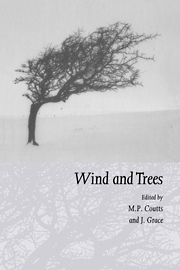Book contents
- Frontmatter
- Contents
- Preface
- List of contributors
- Part I Airflow over topography and in forests
- Part II Mechanics of trees under wind loading
- Part III Tree physiological responses
- Part IV Impacts of wind on forests and ecology
- Part V Risk assessment and management response
- 21 Assessing the risk of wind damage to forests: practice and pitfalls
- 22 Forest wind damage risk assessment for environmental impact studies
- 23 Recommendations for stabilisation of Norway spruce stands based on ecological surveys
- 24 Thinning regime in stands of Norway spruce subjected to snow and wind damage
- 25 A synopsis of windthrow in British Columbia: occurrence, implications, assessement and management
- 26 Wind damage to New Zealand State plantation forests
- 27 The experience of and management strategy adopted by the Selwyn Plantation Board, New Zealand
- Index
22 - Forest wind damage risk assessment for environmental impact studies
Published online by Cambridge University Press: 27 October 2009
- Frontmatter
- Contents
- Preface
- List of contributors
- Part I Airflow over topography and in forests
- Part II Mechanics of trees under wind loading
- Part III Tree physiological responses
- Part IV Impacts of wind on forests and ecology
- Part V Risk assessment and management response
- 21 Assessing the risk of wind damage to forests: practice and pitfalls
- 22 Forest wind damage risk assessment for environmental impact studies
- 23 Recommendations for stabilisation of Norway spruce stands based on ecological surveys
- 24 Thinning regime in stands of Norway spruce subjected to snow and wind damage
- 25 A synopsis of windthrow in British Columbia: occurrence, implications, assessement and management
- 26 Wind damage to New Zealand State plantation forests
- 27 The experience of and management strategy adopted by the Selwyn Plantation Board, New Zealand
- Index
Summary
Abstract
In most European countries, forests are a natural resource of timber. Neglecting information about tree growth, forestry planning and landscape modifications for construction work (e.g. for industrial areas) may result in large economic losses from damage to trees. This chapter presents a method for assessing areas of forest with an increased risk of storm damage due to a proposed landscape modification for a new motorway. The planned new road will cut through a forested mountain ridge, changing both the topography and land-use. A hierarchy of models is applied to simulate winds over hills and changing terrain properties. The first coarse-grid model is on the need to determine wind modification according to the overall topography of the area using synoptic input data. These results are then included as input data for further calculations with fine-scale models. The models are applied to a high-resolution grid which covers the area of the motorway to be built and includes the modifications of landscape and land-use. Finally, wind fields and turbulent kinetic energy are determined at a high spatial resolution for different weather regimes, topographies and land-uses. Areas with an increase or decrease in windspeed will be readily defined as a function of synoptic windspeed and wind direction. The computing facilities required are those of a 486 PC or a workstation.
Introduction
Meteorological variables such as high windspeed and precipitation are known to have an important influence on the risk of damage to trees, together with topography, silvicultural methods, species and stand structure, and the health of the trees (Mayer, 1985).
- Type
- Chapter
- Information
- Wind and Trees , pp. 404 - 423Publisher: Cambridge University PressPrint publication year: 1995
- 2
- Cited by



